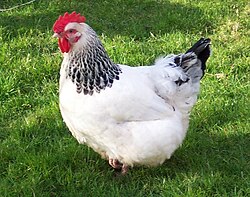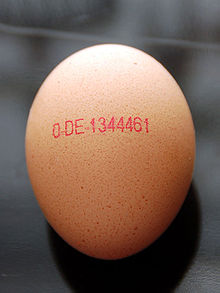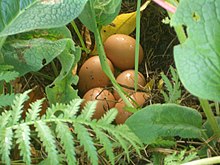
Poultry are domesticated birds kept by humans for their eggs, their meat or their feathers. These birds are most typically members of the superorder Galloanserae (fowl), especially the order Galliformes. The term also includes birds that are killed for their meat, such as the young of pigeons but does not include similar wild birds hunted for sport or food and known as game. The word "poultry" comes from the French/Norman word poule, itself derived from the Latin word pullus, which means "small animal".

Debeaking, beak trimming, or beak conditioning is the partial removal of the beak of poultry, especially layer hens and turkeys although it may also be performed on quail and ducks. Most commonly, the beak is shortened permanently, although regrowth can occur. The trimmed lower beak is somewhat longer than the upper beak. A similar but separate practice, usually performed by an avian veterinarian or an experienced birdkeeper, involves clipping, filing or sanding the beaks of captive birds for health purposes – in order to correct or temporarily alleviate overgrowths or deformities and better allow the bird to go about its normal feeding and preening activities. Amongst raptor-keepers, this practice is commonly known as "coping".

A broiler is any chicken that is bred and raised specifically for meat production. Most commercial broilers reach slaughter weight between four and six weeks of age, although slower growing breeds reach slaughter weight at approximately 14 weeks of age. Typical broilers have white feathers and yellowish skin. Broiler or sometimes broiler-fryer is also used sometimes to refer specifically to younger chickens under 2.0 kilograms, as compared with the larger roasters.

Free-range eggs are eggs produced from birds that may be permitted outdoors. The term "free-range" may be used differently depending on the country and the relevant laws, and is not regulated in many areas.

Free range denotes a method of farming husbandry where the animals, for at least part of the day, can roam freely outdoors, rather than being confined in an enclosure for 24 hours each day. On many farms, the outdoors ranging area is fenced, thereby technically making this an enclosure, however, free range systems usually offer the opportunity for the extensive locomotion and sunlight that is otherwise prevented by indoor housing systems. Free range may apply to meat, eggs or dairy farming.

Forced molting, sometimes known as induced molting, is the practice by some poultry industries of artificially provoking a flock to molt simultaneously, typically by withdrawing food for 7–14 days and sometimes also withdrawing water for an extended period. Forced molting is usually implemented when egg-production is naturally decreasing toward the end of the first egg-laying phase. During the forced molt, the birds cease producing eggs for at least two weeks, which allows the bird's reproductive tracts to regress and rejuvenate. After the molt, the hen's egg production rate usually peaks slightly lower than the previous peak, but egg quality is improved. The purpose of forced molting is therefore to increase egg production, egg quality, and profitability of flocks in their second or subsequent laying phases, by not allowing the hen's body the necessary time to rejuvenate during the natural cycle of feather replenishment.

Battery cages are a housing system used for various animal production methods, but primarily for egg-laying hens. The name arises from the arrangement of rows and columns of identical cages connected, in a unit, as in an artillery battery. Although the term is usually applied to poultry farming, similar cage systems are used for other animals. Battery cages have generated controversy between advocates for animal welfare and industrial producers.

Intensive animal farming or industrial livestock production, also known by its opponents as factory farming and macro-farms, is a type of intensive agriculture, specifically an approach to animal husbandry designed to maximize production, while minimizing costs. To achieve this, agribusinesses keep livestock such as cattle, poultry, and fish at high stocking densities, at large scale, and using modern machinery, biotechnology, and global trade. The main products of this industry are meat, milk and eggs for human consumption. There are issues regarding whether intensive animal farming is sustainable in the social long-run given its costs in resources. Analysts also raise issues about its ethics.

Poultry farming is the form of animal husbandry which raises domesticated birds such as chickens, ducks, turkeys and geese to produce meat or eggs for food. Poultry – mostly chickens – are farmed in great numbers. More than 60 billion chickens are killed for consumption annually. Chickens raised for eggs are known as layers, while chickens raised for meat are called broilers.

Proposition 2 was a California ballot proposition in that state's general election on November 4, 2008. It passed with 63% of the votes in favor and 37% against. Submitted to the Secretary of State as the Prevention of Farm Animal Cruelty Act, the initiative's name was amended to officially be known as the Standards for Confining Farm Animals initiative. The official title of the statute enacted by the proposition is the Prevention of Farm Animal Cruelty Act.
The Organic Foods Production Act of 1990 (OFPA) authorizes a National Organic Program (NOP) to be administered by USDA's Agricultural Marketing Service (AMS). The program is based on federal regulations that define standard organic farming practices and on a National List of acceptable organic production inputs. Private and state certifiers visit producers, processors, and handlers to certify that their operations abide by the standards. Once certified, these operations may affix the USDA Organic Seal. USDA has established four distinct categories for labeling organic products—100 percent organic, organic, "made with" organic ingredients, and specific organic ingredients—and only 100 percent organic and organic categories can use the USDA Organic Seal. It is illegal for anyone to use the word "organic" on a product if it does not meet the standards set in the law and regulations. The regulations under the OFPA are intended to set uniform minimum standards for organic production. However, states may adopt additional requirements after review and approval by USDA. AMS re-accredits certifying agents every 5 years, maintains federal oversight to assure truth in labeling, and provides assurance that imported organic products have been produced under standards that are equivalent to the U.S. standards.

Poultry farming is a part of the United States's agricultural economy.

Feather pecking is a behavioural problem that occurs most frequently amongst domestic hens reared for egg production, although it does occur in other poultry such as pheasants, turkeys, ducks, broiler chickens and is sometimes seen in farmed ostriches. Feather pecking occurs when one bird repeatedly pecks at the feathers of another. The levels of severity may be recognized as mild and severe. Gentle feather pecking is considered to be a normal investigatory behaviour where the feathers of the recipient are hardly disturbed and therefore does not represent a problem. In severe feather pecking, however, the feathers of the recipient are grasped, pulled at and sometimes removed. This is painful for the receiving bird and can lead to trauma of the skin or bleeding, which in turn can lead to cannibalism and death.

Cannibalism in poultry is the act of one individual of a poultry species consuming all or part of another individual of the same species as food. It commonly occurs in flocks of domestic hens reared for egg production, although it can also occur in domestic turkeys, pheasants and other poultry species. Poultry create a social order of dominance known as pecking order. When pressure occurs within the flock, pecking can increase in aggression and escalate to cannibalism. Cannibalism can occur as a consequence of feather pecking which has caused denuded areas and bleeding on a bird's skin. Cannibalism can cause large mortality rates within the flock and large decreases in production due to the stress it causes. Vent pecking, sometimes called 'cloacal cannibalism', is considered to be a separate form of cannibalistic pecking as this occurs in well-feathered birds and only the cloaca is targeted. There are several causes that can lead to cannibalism such as: light and overheating, crowd size, nutrition, injury/death, genetics and learned behaviour. Research has been conducted to attempt to understand why poultry engage in this behaviour, as it is not totally understood. There are known methods of control to reduce cannibalism such as crowd size control, beak trimming, light manipulation, perches, selective genetics and eyewear.

A furnished cage, sometimes called enriched cage, colony cage or modified cage, is a type of cage used in poultry farming for egg laying hens. Furnished cages have been designed to overcome some of the welfare concerns of battery cages whilst retaining their economic and husbandry advantages, and also provide some of the welfare advantages over non-cage systems. Many design features of furnished cages have been incorporated because research in animal welfare science has shown them to be of benefit to the hens.

Egg marking is a form of egg labelling that includes an egg code stamped on the egg itself. In the EU there is a producer code regulated by law since 2004. It allows consumers to distinguish free range eggs and organic farming eggs from the industrial caged hen production.
Given the variety of diseases prevalent in swine production it is important to understand the risks associated with organic swine production. Overall numbers for certified organic livestock remain low compared to the overall U.S. swine numbers, with approximately 12,000 animals in 2011. However, since 1992, stocks have increased dramatically, with an annual growth rate of 20 percent in total U.S. organic stock. Additionally, there are thousands of non-certified organic swine herds which are not accounted in official statistics, but where farmers still use organic production practices. Consumer demand, stemming from the larger organic agriculture movement has helped spurred growth in this industry. The overall segment, although minuscule compared to the conventional national average, still represents a strong and growing segment in U.S. pork production. The definition of organic swine according to the USDA National Organic Program (NOP), is largely unchanged:

Farmageddon: The True Cost of Cheap Meat is a 2014 non-fiction book by Philip Lymbery and Isabel Oakeshott. It surveys the effects of industrial livestock production and industrial fish farming around the world. The book is the result of Lymbery's investigations for which he travelled the world over three years. Isabel Oakeshott is the political editor of The Sunday Times, Lymbery is CEO of Compassion in World Farming. The book was published by Bloomsbury.
Animal welfare and rights in France is about the treatment of and laws concerning non-human animals in France. France has moderate animal welfare protections by international standards.
Antibiotics in poultry farming in America is the controversial prophylactic use of antibiotics in the country's poultry farming industry. This does not represent the position in other countries.

















